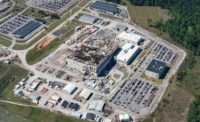Before 56 million gallons of long-stored radioactive waste at the federal Hanford nuclear waste site in Washington state can be turned into vitrified glass for disposal beginning in 2024, crews from the U.S. Energy Dept and Bechtel National that built and are commissioning the site's giant waste vitrification plant need to heat up its two 300-ton melters, the world's largest, to 2,100° F.
The first melter heatup process began in October 2022 at the Hanford vitrification plant complex—now a 21-year project with an estimated $17 billion cost—but was stopped after two days at the hold point of 300° F, according to Bechtel. Increased temperatures in the melter's power supply electrical cabinet from temporary heaters forced officials to abandon the heatup and conduct an analysis of the power supply circuit and interaction between cabinet components.
The effort succeeded when the temperature milestone was finally reached on July 20, one month after heatup restarted. Officials said while the melters were designed to run continuously, the cooldown since last year has not hurt them.
Led by Bechtel National, the Hanford vitrification project includes completion of the process to glassify most of the site’s plutonium processing waste before more complex engineering decisions are made on how to treat high-level radioactive waste there. Technical issues forced a pause about a decade ago in construction of facilities intended to treat that material.
“Completing heatup of the first melter is a major step forward for Hanford’s tank waste mission,” says Ed Dawson, U.S. Dept. of Energy spokesperson.
Mat Irwin, department deputy vitrification plant assistant manager, said line filters in three power supplies overheated and filters in all three electrical cabinets showed thermal damage.
During evaluation of the joule heater power supply that will maintain the molten glass pool during normal operation over the five-year lifespan of the side-by-side melters, each 20 ft by 30 ft and 16 ft high, site officials detected a potential challenge different than what was discovered with the startup heater power supply, he said.
Lessons Learned
The fix required replacement of the line filter core and an alternate line filter, but with a new design to prevent future overheating issues. The line reactors and inductors in the new filter are now designed to handle sustained high frequency harmonics, particularly at low power levels, Irwin told ENR. Steel in the core that is 2.5 times heavier also helps reduce heat generation, since its added weight requires more energy to heat to the point of damage, he added.
The system also has introduced water cooling on the secondary side of the transformer and a separate cooling fan with “substantial open space” assists with heat dissipation, he said.
Changes implemented in the first melter design are being incorporated into the second one.
“This was a highly complex, challenging step to achieve,” said Staci West, a Bechtel spokesperson. “We will maintain the same rigor and focus on safety and quality as we take the next steps in our commissioning process.”
Bechtel said "project work shifts when technical challenges arise to try to balance cost and schedule impacts of delays and offset them with advances in other areas." According to the firm, the delay "is not affecting mandated operational start of the vitrification plant within its pandemic-revised timeline to treat underground tank-stored waste next year.
The next critical step irequires adding frit—glass beads—to the melter, Bechtel said. That process will create a molten pool to cover the electrodes and initiate joule heating. Bubblers will be installed to introduce air into the bottom of the melter glass pool to mix the glass. Additional glass frit will raise the pool to the normal operating level so the melter can then receive non-hazardous simulation material.
Bechtel anticipates heatup of the second melter later in 2023, with more system testing to take lessons learned from the first one for needed changes before waste simulants are vitrified.




Post a comment to this article
Report Abusive Comment